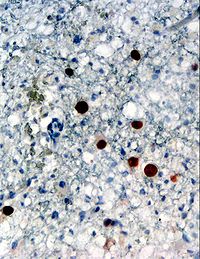
Photo from wikipedia
Animal models are crucial in advancing biomedical research and defining the pathogenesis of human disease. Unfortunately, not all diseases can be easily modeled in a nonhuman host or such models… Click to show full abstract
Animal models are crucial in advancing biomedical research and defining the pathogenesis of human disease. Unfortunately, not all diseases can be easily modeled in a nonhuman host or such models are cost prohibitive to generate, including models for the human-specific virus JC polyomavirus (JCPyV). JCPyV infects most of the population but can cause a rare, fatal disease, progressive multifocal leukoencephalopathy (PML). There have been considerable advancements in understanding the molecular mechanisms of JCPyV infection, but this has mostly been limited to immortalized cell culture models. In contrast, PML pathogenesis research has been greatly hindered because of the lack of an animal model. We have further characterized JCPyV infection in primary human astrocytes to better define the infectious process in a primary cell type. Albeit a cell culture model, primary astrocytes may better recapitulate human disease, are easier to maintain than other primary cells, and are less expensive than using an animal model. ABSTRACT JC polyomavirus (JCPyV) infects 50 to 80% of the population and is the causative agent of a fatal demyelinating disease of the central nervous system (CNS). JCPyV presents initially as a persistent infection in the kidneys of healthy people, but during immunosuppression, the virus can reactivate and cause progressive multifocal leukoencephalopathy (PML). Within the CNS, JCPyV predominately targets two cell types, oligodendrocytes and astrocytes. Until recently, the role of astrocytes has been masked by the pathology in the myelin-producing oligodendrocytes, which are lytically destroyed by the virus. To better understand how astrocytes are impacted during JCPyV infection, the temporal regulation and infectious cycle of JCPyV were analyzed in primary normal human astrocytes (NHAs). Previous research to define the molecular mechanisms underlying JCPyV infection has mostly relied on the use of cell culture models, such as SVG-A cells (SVGAs), an immortalized, mixed population of glial cells transformed with simian virus 40 (SV40) T antigen. However, SVGAs present several limitations due to their immortalized characteristics, and NHAs represent an innovative approach to study JCPyV infection in vitro. Using infectivity assays, quantitative PCR, and immunofluorescence assay approaches, we have further characterized JCPyV infectivity in NHAs. The JCPyV infectious cycle is significantly delayed in NHAs, and the expression of SV40 T antigen alters the cellular environment, which impacts viral infection in immortalized cells. This research establishes a foundation for the use of primary NHAs in future studies and will help unravel the role of astrocytes in PML pathogenesis. IMPORTANCE Animal models are crucial in advancing biomedical research and defining the pathogenesis of human disease. Unfortunately, not all diseases can be easily modeled in a nonhuman host or such models are cost prohibitive to generate, including models for the human-specific virus JC polyomavirus (JCPyV). JCPyV infects most of the population but can cause a rare, fatal disease, progressive multifocal leukoencephalopathy (PML). There have been considerable advancements in understanding the molecular mechanisms of JCPyV infection, but this has mostly been limited to immortalized cell culture models. In contrast, PML pathogenesis research has been greatly hindered because of the lack of an animal model. We have further characterized JCPyV infection in primary human astrocytes to better define the infectious process in a primary cell type. Albeit a cell culture model, primary astrocytes may better recapitulate human disease, are easier to maintain than other primary cells, and are less expensive than using an animal model.
Journal Title: Journal of Virology
Year Published: 2019
Link to full text (if available)
Share on Social Media: Sign Up to like & get
recommendations!